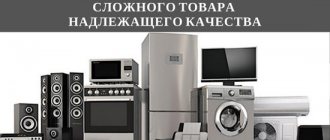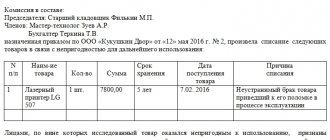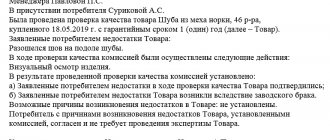What are consumer properties of goods
The definition is given in GOST 51303-2013 - these are the characteristics that distinguish a product from similar ones, which are the purpose of its use and consumption.
There is no law establishing a list of properties. They are derived by commodity research specialists and marketers.
Free HOTLINE:
Moscow time 8 (499) 938 6124
St. Petersburg 8 (812) 425 6761
Fed 8 (800) 350 8362
An approximate list is contained in Article 10 of the “Law on the Protection of Consumer Rights”:
- used food additives;
- the nutritional value;
- conditions of use and storage;
- date, place and method of manufacture;
- contraindications.
Requirements
A purchase is considered reliable if it has no defects and has not demonstrated them during the shelf life, service, warranty, meets the stated requirements, and can be repaired with proper use.
Product safety is determined by compliance with:
- Standards for exposure to humans and the environment (MPC, PDN).
- GOST.
- Technical regulations (of the Russian Federation, member countries of the Customs Union).
- SNiPam.
- SanPiNam (especially relevant for food products. Any product should not violate sanitary and hygienic standards, as otherwise it will harm human health).
In this case, security means:
- chemical;
- physical;
- biological;
- fire protection;
- sanitary
Product functional characteristics
These include all those properties that speak about the main purpose of the product and service. For example, for a ballpoint pen, this will be the clarity and purity of the lines and dots it leaves on the paper. For clothing - durability when worn, for shoe covers - reliability in providing an obstacle between shoes and the surface.
Functional excellence depends on various parameters: quality of raw materials, workmanship, etc., and all of them must be combined with each other. Any thing is intended for something, and its meaning is to ensure the fullest satisfaction of consumer expectations.
The manufacturer is responsible for authenticity. Authenticity and quality control is carried out by special control bodies, such as Rospotrebnadzor, Gosstandart, sanitary doctors, inspectors of departments and control departments at enterprises. But ultimately, the consumer determines how well the purchased product meets its specified characteristics.
Successful brands in marketing often suffer from the fact that their represented products are counterfeited. Not only the companies themselves, whose brand is used by unscrupulous copyists, suffer from this reputation, but also consumers who fall into the trap of deceivers and buy a product that does not meet their expectations.
It happens that for some reason, goods of proper and inadequate quality need to be returned back to the store or exchanged, so you need to know some of the nuances of the procedure:
- Return and exchange terms.
- What products cannot be returned or exchanged?
- Is it possible to return goods of good quality, what is the list of such goods, what if the seller refuses to return the money, and what is the procedure for returning and exchanging according to the law?
- How do you return goods of inadequate quality, and how do you file a claim for a refund?
Classification of goods
The creation of products is based on their ergonomics, i.e. ability to satisfy user desires. The following properties are distinguished:
- Anthropometric. Compliance with average height, weight, size.
- Physiological. They correspond to the functional characteristics of the human body.
- Psychological. The ability to satisfy customer needs through taste, smell, appearance, volume, brightness.
- Aesthetic. Artistic value, beauty.
- Ecological. Impact on the natural environment during production and consumption.
- Security.
- Social. Frequency of purchase, depending on the season, time of year, fashion, income, public morality.
- Functional. The ability to fulfill a purpose, i.e. functionality declared by the seller or manufacturer.
- Economical. Minimal costs are required during production and use.
IMPORTANT: each type of product has a unique number, approved by order of the Ministry of Economic Development of the Russian Federation of 2011 No. 273. This list is called the nomenclature of consumer properties and quality indicators of goods.
There are a lot of technical regulations of the Customs Union, GOSTs, which approve the characteristics of certain products, similar to the terminology of the nomenclature.
For example, the Decision of the Customs Union Commission “On the adoption of the technical regulations of the Customs Union “On the safety of perfumery and cosmetic products” of 2011 No. 799 and GOST 33488-2015 adopted in accordance with it. Or regulation 007/2011, which contains requirements for office supplies.
Food
Food products are created for consumption, i.e. this is food, drinks. There are additional parameters for food products:
- The nutritional value:
- energy (number of calories);
- biological (content of vitamins and other useful substances);
- physiological (content of carbohydrates, fats, proteins).
- Culinary and technological.
- Degree of digestibility.
By type, food products are divided into:
- animal and plant origin;
- auxiliary – not consumed separately from other groups (pepper, salt, sugar, seasonings, spices);
- mixed.
Non-food
Reliable:
- life time;
- possibility of repair;
- wear and tear over time.
Non-food products are divided into:
- clothes;
- shoes;
- textile;
- hygiene items;
- jewelry;
- household chemicals;
- vehicles;
- furniture;
- animals;
- plants;
- books, magazines;
- others.
The concept of goods and services. Features of goods. Types of goods. The concept of price.
Every day we use transportation, health and education services. We purchase agricultural, light industry and pharmaceutical goods. We ask a neighbor to do a small favor, and tell our friend that our favorite store has announced discounts on some products. At the same time, we never think about what such familiar words and at the same time such incomprehensible economic terms as “product” or “service” mean.
A commodity is a product of labor produced for exchange (sale). It must satisfy the human needs for which it was created.
Services are a product of labor intended to satisfy mainly the spiritual and mental needs of a person. The service can also be sold or exchanged. So how can we distinguish between what we are buying – a product or a service? For example, we came to the post office to send a parcel. There we buy a special box to pack our things. We paid money for it. Having packed the parcel, we ask the postal operator to send it and also pay money. But in the first case we pay for the goods, and in the second we pay for the service.
This means that the product is tangible, it has a material shell. You can touch it and look at it.
All products, depending on their purpose, service life and other parameters, can be divided into the following types:
| Basis for classification | Types of goods |
| Purpose of use | a) consumer goods (for personal, non-commercial use); b) industrial goods. |
| Duration and features of use | a) durable goods (household appliances, furniture, cars, etc.); b) non-durable goods (food, magazines, newspapers, cosmetics, etc.); |
| Features of the approach to selection and purchase | a) everyday goods that are purchased without a long study of the market and prices (food, stationery, household chemicals, etc.); b) carefully selected goods that require long-term use and are therefore selected more carefully (household appliances, cars, clothing, shoes, etc.); c) prestigious goods that are usually bought only because of a special image or special, unique quality (exotic fruits, fashionable clothes, expensive cosmetics). |
Within each type of product, several groups can also be distinguished. For example, industrial goods may include work machinery, vehicles (tugs, barges), chemical equipment, etc.
The product is manufactured using certain technologies, has an established production procedure and, quite often, must comply with state standards. If your mother sends you to the store every day with a request to buy a package of apple juice from a specific manufacturer, then you bring home the same packages every day. A product, unlike a service, can be patented and ownership rights established over it.
The consumer, as a rule, is not present during the manufacturing process of the product. A product is produced and offered to the buyer in different places and at different times.
And the service is intangible. This is a process that cannot be touched, felt and, naturally, cannot be stored in a warehouse.
It is impossible to present a service exactly the same twice. Even if it is provided by the same company or person over and over again, the result may be different. You want to find out what properties a particular product has and make this request to a sales consultant. One consultant will tell you in detail about all the functions of the product, the manufacturer, warranty, and price. And the second will limit itself to information only about the technical characteristics of this product.
The service involves the direct participation of the consumer in the “production” process and the influence of his wishes and requirements on the final result. A service, unlike a product, has the property of simultaneous production and consumption.
Products and services can be sold, exchanged, or donated. In order to perform all these operations, the product and service must have a price.
Price is the amount of money in exchange for which the seller is willing to transfer (sell) a unit of goods (services). In essence, price is the rate of exchange of a specific product (service) for money.
The price of a product (service) is based on the cost price, which refers to the manufacturer’s own costs. These costs include the cost of consumed materials, semi-finished products, wages of workers involved in the production of this product and other costs associated with the production and sale of this product. In addition, to determine the price of a product, the manufacturer must take into account individual taxes, which, according to the law, are included in the price, as well as the percentage of its own profit.
In other words, price is the monetary expression of the value of a product, which is determined and established depending on the costs of manufacturing, selling the product, and mandatory payments to the budget. The net income that is needed for the enterprise to bring profit to the owner is also taken into account.
Price = (Cost + Profit) + Taxes
Prices for services are set in a similar way, although this process is somewhat more complicated than setting the price of a product.
PRACTICAL TASKS:
Exercise 1.
Determine the cost per unit of production if in the reporting period the organization produced 1,500 units, while its own costs amounted to 420 thousand rubles, the planned profit percentage was 15%, mandatory tax payments were 20%.
Task 2.
Determine the cost of a TV repair service if the workshop replaced the failed parts with new ones costing 1,040 rubles. The worker who carried out the repair spent 3.5 hours. His hourly rate is 150 rubles. For the month, the workshop paid the bill for rent and utility bills of 5,100 rubles. (There are 170 working hours in a month). The planned percentage of profit is 10%, and the amount of tax payments is 20%.







